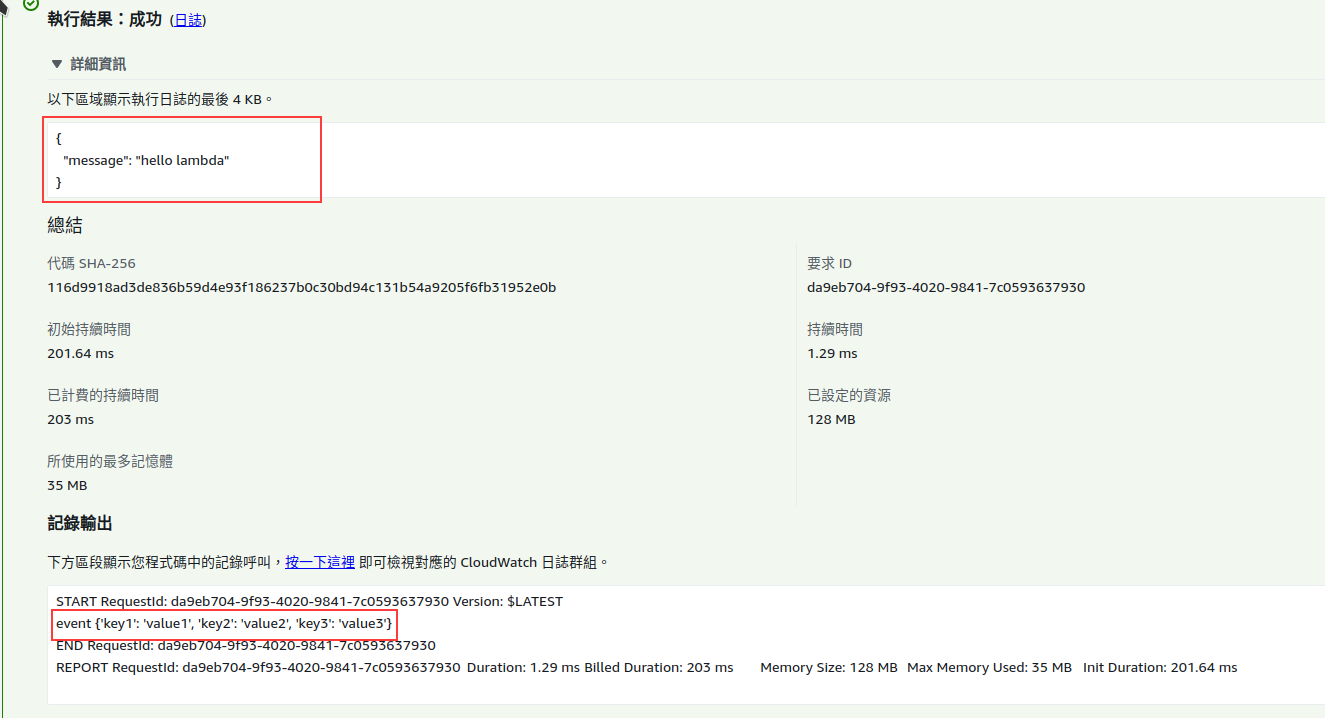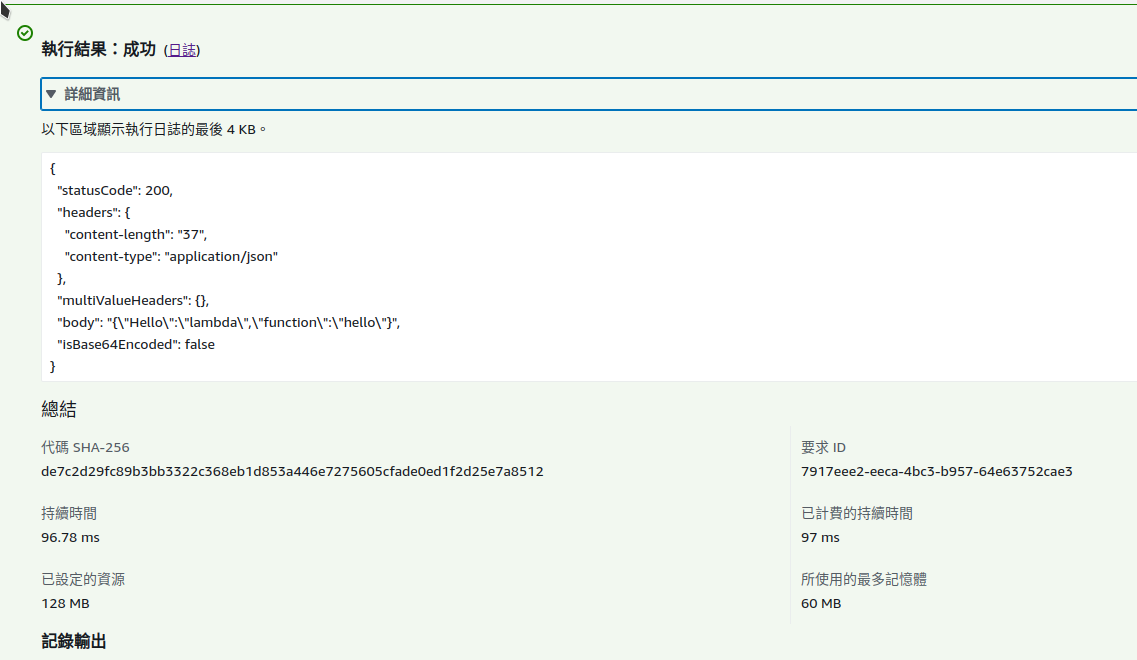在AWS Lambda中使用python docker
基本的python代碼
refs
app.py
def handler(event, context):
print('event', event)
return {
'message': "hello lambda"
}
Dockerfile
FROM public.ecr.aws/lambda/python:3.9
COPY app.py ${LAMBDA_TASK_ROOT}
CMD [ "app.handler" ]
Docker Build/Push
需要先建立好ECR Repository
並確認AWS CLI擁有ECR權限
docker build -t lambda-python .
docker tag lambda-python:latest {ECR_REPOSITORY_URI}:latest
docker push {ECR_REPOSITORY_URI}:latest
本機測試
先將服務啟動
docker run -p 9000:8080 lambda-python
使用curl測試
curl -XPOST "http://localhost:9000/2015-03-31/functions/function/invocations" -d '{"foo": "bar"}'
服務Log

執行輸出

Lambda測試結果

使用Fastapi佈署至Lambda整合API Gateway
這段會使用Mangum python套件來處理來自API Gateway的請求
Mangum會將將API Gateway的請求都處理好可以直接丟給fastapi
refs
main.py
建議一個簡易的fastapi程式碼main.py
並安裝使用Mangum套件
from fastapi import FastAPI
from mangum import Mangum
app = FastAPI()
@app.get("/")
def index():
return {"Hello": "lambda", "function": "index"}
@app.get("/hello")
def hello():
return {"Hello": "lambda", "function": "hello"}
@app.get("/test")
def hello():
return {"Hello": "lambda", "function": "test"}
handler = Mangum(app, lifespan="off")
Dockerfile
FROM public.ecr.aws/lambda/python:3.9
COPY main.py ${LAMBDA_TASK_ROOT}
COPY requirements.txt .
RUN pip3 install -r requirements.txt --target "${LAMBDA_TASK_ROOT}"
CMD [ "main.handler" ]
在本機測試
docker image build完之後可以在本機先執行起來測試
因為要模擬AWS API Gateway的AWS Proxy請求
所以會有這麼長的json要帶
可依照測試情況調整method及路由(共有3處的路由要調整)
這邊的路由可以直接對到fastapi的api路由
curl curl -XPOST "http://localhost:9000/2015-03-31/functions/function/invocations" \
-d '{
"body": "eyJ0ZXN0IjoiYm9keSJ9",
"resource": "/{proxy+}",
"path": "/hello",
"httpMethod": "GET",
"isBase64Encoded": true,
"queryStringParameters": {
"foo": "bar"
},
"multiValueQueryStringParameters": {
"foo": [
"bar"
]
},
"pathParameters": {
"proxy": "/hello"
},
"stageVariables": {
"baz": "qux"
},
"headers": {
"Accept": "text/html,application/xhtml+xml,application/xml;q=0.9,image/webp,*/*;q=0.8",
"Accept-Encoding": "gzip, deflate, sdch",
"Accept-Language": "en-US,en;q=0.8",
"Cache-Control": "max-age=0",
"CloudFront-Forwarded-Proto": "https",
"CloudFront-Is-Desktop-Viewer": "true",
"CloudFront-Is-Mobile-Viewer": "false",
"CloudFront-Is-SmartTV-Viewer": "false",
"CloudFront-Is-Tablet-Viewer": "false",
"CloudFront-Viewer-Country": "US",
"Host": "1234567890.execute-api.us-east-1.amazonaws.com",
"Upgrade-Insecure-Requests": "1",
"User-Agent": "Custom User Agent String",
"Via": "1.1 08f323deadbeefa7af34d5feb414ce27.cloudfront.net (CloudFront)",
"X-Amz-Cf-Id": "cDehVQoZnx43VYQb9j2-nvCh-9z396Uhbp027Y2JvkCPNLmGJHqlaA==",
"X-Forwarded-For": "127.0.0.1, 127.0.0.2",
"X-Forwarded-Port": "443",
"X-Forwarded-Proto": "https"
},
"multiValueHeaders": {
"Accept": [
"text/html,application/xhtml+xml,application/xml;q=0.9,image/webp,*/*;q=0.8"
],
"Accept-Encoding": [
"gzip, deflate, sdch"
],
"Accept-Language": [
"en-US,en;q=0.8"
],
"Cache-Control": [
"max-age=0"
],
"CloudFront-Forwarded-Proto": [
"https"
],
"CloudFront-Is-Desktop-Viewer": [
"true"
],
"CloudFront-Is-Mobile-Viewer": [
"false"
],
"CloudFront-Is-SmartTV-Viewer": [
"false"
],
"CloudFront-Is-Tablet-Viewer": [
"false"
],
"CloudFront-Viewer-Country": [
"US"
],
"Host": [
"0123456789.execute-api.us-east-1.amazonaws.com"
],
"Upgrade-Insecure-Requests": [
"1"
],
"User-Agent": [
"Custom User Agent String"
],
"Via": [
"1.1 08f323deadbeefa7af34d5feb414ce27.cloudfront.net (CloudFront)"
],
"X-Amz-Cf-Id": [
"cDehVQoZnx43VYQb9j2-nvCh-9z396Uhbp027Y2JvkCPNLmGJHqlaA=="
],
"X-Forwarded-For": [
"127.0.0.1, 127.0.0.2"
],
"X-Forwarded-Port": [
"443"
],
"X-Forwarded-Proto": [
"https"
]
},
"requestContext": {
"accountId": "123456789012",
"resourceId": "123456",
"stage": "prod",
"requestId": "c6af9ac6-7b61-11e6-9a41-93e8deadbeef",
"requestTime": "09/Apr/2015:12:34:56 +0000",
"requestTimeEpoch": 1428582896000,
"identity": {
"cognitoIdentityPoolId": null,
"accountId": null,
"cognitoIdentityId": null,
"caller": null,
"accessKey": null,
"sourceIp": "127.0.0.1",
"cognitoAuthenticationType": null,
"cognitoAuthenticationProvider": null,
"userArn": null,
"userAgent": "Custom User Agent String",
"user": null
},
"path": "/prod/hello",
"resourcePath": "/{proxy+}",
"httpMethod": "POST",
"apiId": "1234567890",
"protocol": "HTTP/1.1"
}
}'

在Lambda上測試
在lambda的測試可以選API Gateway AWS Proxy範本
一樣可調整Method及路由來測試


設定API Gateway
API Gateway設定很簡單
不用依照fastapi實際的所有api一個一個建立在API Gateway上
API Gateway提供一個Lambda Proxy Resource的方式來整合
只要建立Resource的時候勾選代理資源

接著整合類型選擇Lambda Function並設定好對應的Function即可

儲存後API Gateway的路由就可以直接對應所有Lambda中fastapi的路由
API Root設定
前面的設定除了root api之外
所有的規則都可以直接導向Lambda(例如: /foo, /bar, /foo/bar, /a/b/c)
但root需要額外設定
如果需要root api可以被使用的話必須設定Root的Get Method
然後一樣要設定Lambda及使用Lambda Proxy

使用aws python client library的注意事項
若要存取其他AWS服務
通常會用boto3套件來開發
在lambda上有些要注意的事項
因為在Lambda上會自動賦予一個Role(在建立Lambda Function的時候設定的Role)
而在Lambda上使用boto3套件的時候
會自動使用這個Role取得臨時憑證(STS Token)來存取AWS服務
因此如果在其他環境如果有使用IAM Key來存取AWS資源的話
需要分兩種模式
- 使用Assume Role的方式透過STS Token存取
- 透過IAM Key存取
範例
以下為一段建立S3物件準備存取S3服務的範例
這邊可以看到透過settings(pydantic settings)來依照環境變數確認當下是否在Lambda中
如果是在Lambda中就不設定IAM Key直接使用Assume Role STS Token
如果不是在Lambda中就直接使用IAM Key
class S3Service:
def __init__(self):
if settings.IN_LAMBDA is True:
self.s3 = boto3.client('s3')
else:
session = boto3.Session(
aws_access_key_id=settings.AWS_ACCESS_KEY_ID,
aws_secret_access_key=settings.AWS_ACCESS_KEY_SECRET,
)
self.s3 = session.client('s3')
在Lambda中使用IAM Key
如果直接在Lambda中使用IAM Key存取
仍無法正常使用
會發現IAM Key仍會被Assume Role的STS Token蓋掉
Terraform
如果是使用上述Mangum套件的情況加上使用Docker類型的Lambda Function
通常就是會需要ECR+API Gateway+Lambda+CloudWatch這些資源
這邊提供一個完整的terraform應用程式範例
透過terraform建立以下資源、設定
- ECR Repository
- API Gateway
- API(Index API、Proxy API)
- Lambda Proxy
- Usage Plan
- API Key
- Stage
- Deploy
- Lambda
- CloudWatch
- IAM
- Lambda assume role
執行terraform的AWS CLI IAM權限
- IAM FullAccess
- API Gateway FullAccess
- Lambda FullAccess
- ECR FullAccess
- CloudWatch FullAccess(調整Log Group retention time)
main.tf
variable "aws_profile" {
type = string
default = "default"
}
variable "aws_region" {
type = string
default = "us-east-1"
}
variable "service_name" {
type = string
}
variable "ecr_repo_name" {
type = string
}
variable "api_gateway_stage_name" {
type = string
default = "dev"
}
variable "api_key" {
type = string
default = "abced12345abced12345"
}
data "aws_caller_identity" "current" {}
locals {
aws_account_id = data.aws_caller_identity.current.account_id
ecr_host = "${local.aws_account_id}.dkr.ecr.${var.aws_region}.amazonaws.com"
lambda_image_uri = "${local.ecr_host}/${var.ecr_repo_name}:latest"
}
terraform {
required_providers {
aws = {
source = "hashicorp/aws"
version = "~> 4.16"
}
}
required_version = ">= 1.2.0"
}
provider "aws" {
region = "ap-southeast-1"
profile = var.aws_profile
}
ECR
這邊會建立一個ECR Repository
並立即push一個最簡單的alpine image
原因是要建立docker lambda function一開始就必須指定一個image
因此為了能夠順利建立lambda function
一開始會先push一個image
resource "aws_ecr_repository" "ecr" {
name = var.ecr_repo_name
force_delete = true
}
resource "null_resource" "build_push_image" {
depends_on = [aws_ecr_repository.ecr]
provisioner "local-exec" {
command = templatefile("${path.module}/build_push_image.sh", {
IMAGE_TAG = local.lambda_image_uri
ECR_HOST = local.ecr_host
REGION = var.aws_region
})
}
}
build_push_image.sh如下
echo "FROM alpine" > Dockerfile
aws ecr get-login-password --region ${REGION} | docker login --username AWS --password-stdin ${ECR_HOST}
docker build -t ${IMAGE_TAG} .
docker push ${IMAGE_TAG}
Lambda
# 設定cloud watch log retention
resource "aws_cloudwatch_log_group" "log_group" {
name = "/aws/lambda/${aws_lambda_function.lambda-function.function_name}"
retention_in_days = 3
}
# lambda function
resource "aws_lambda_function" "lambda-function" {
depends_on = [null_resource.build_push_image]
function_name = var.service_name
role = aws_iam_role.lambda-assume-role.arn
package_type = "Image"
image_uri = local.lambda_image_uri
environment {
variables = {
MODE: "lambda",
}
}
}
# lambda assume role設定
resource "aws_iam_role" "lambda-assume-role" {
name = "lambda-${var.service_name}-iam"
assume_role_policy = <<EOF
{
"Version": "2012-10-17",
"Statement": [
{
"Effect": "Allow",
"Principal": {
"Service": "lambda.amazonaws.com"
},
"Action": "sts:AssumeRole"
}
]
}
EOF
}
# 設定lambda使用的role有基本的cloud watch寫入權限(AWSLambdaBasicExecutionRole), 否則無法寫入log至cloudwatch
resource "aws_iam_role_policy_attachment" "lambda_policy_attachment" {
role = aws_iam_role.lambda-assume-role.name
policy_arn = "arn:aws:iam::aws:policy/service-role/AWSLambdaBasicExecutionRole"
}
# 設定lambda使用的role有基本的S3完整權限
resource "aws_iam_role_policy_attachment" "lambda_role_s3_fullaccess_attachment" {
policy_arn = "arn:aws:iam::aws:policy/AmazonS3FullAccess"
role = aws_iam_role.lambda-assume-role.name
}
# ref: https://registry.terraform.io/providers/hashicorp/aws/latest/docs/resources/lambda_permission
# 允許api gateway存取lambda
resource "aws_lambda_permission" "apigw_lambda" {
statement_id = "AllowExecutionFromAPIGateway"
action = "lambda:InvokeFunction"
function_name = aws_lambda_function.lambda-function.function_name
principal = "apigateway.amazonaws.com"
# More: http://docs.aws.amazon.com/apigateway/latest/developerguide/api-gateway-control-access-using-iam-policies-to-invoke-api.html
source_arn = "arn:aws:execute-api:${var.aws_region}:${local.aws_account_id}:${aws_api_gateway_rest_api.service.id}/*/*"
}
API Gateway
# ref: https://registry.terraform.io/providers/hashicorp/aws/latest/docs/resources/api_gateway_rest_api
resource "aws_api_gateway_rest_api" "service" {
name = var.service_name
endpoint_configuration {
types = ["REGIONAL"]
}
}
# index method
resource "aws_api_gateway_method" "index" {
rest_api_id = aws_api_gateway_rest_api.service.id
resource_id = aws_api_gateway_rest_api.service.root_resource_id
http_method = "GET"
api_key_required = true
authorization = "NONE"
}
resource "aws_api_gateway_integration" "index" {
rest_api_id = aws_api_gateway_rest_api.service.id
resource_id = aws_api_gateway_rest_api.service.root_resource_id
http_method = "GET"
type = "AWS_PROXY"
uri = aws_lambda_function.lambda-function.invoke_arn
integration_http_method = "POST"
connection_type = "INTERNET"
lifecycle {
ignore_changes = [connection_type]
}
}
# proxy
resource "aws_api_gateway_resource" "proxy" {
rest_api_id = aws_api_gateway_rest_api.service.id
parent_id = aws_api_gateway_rest_api.service.root_resource_id
path_part = "{proxy+}"
}
resource "aws_api_gateway_method" "proxy" {
rest_api_id = aws_api_gateway_rest_api.service.id
resource_id = aws_api_gateway_resource.proxy.id
http_method = "ANY"
authorization = "NONE"
api_key_required = true
}
resource "aws_api_gateway_integration" "proxy" {
rest_api_id = aws_api_gateway_rest_api.service.id
resource_id = aws_api_gateway_resource.proxy.id
http_method = aws_api_gateway_method.proxy.http_method
type = "AWS_PROXY"
uri = aws_lambda_function.lambda-function.invoke_arn
integration_http_method = "POST"
connection_type = "INTERNET"
lifecycle {
ignore_changes = [connection_type]
}
}
# deploy
resource "aws_api_gateway_deployment" "deploy" {
rest_api_id = aws_api_gateway_rest_api.service.id
triggers = {
redeployment = sha1(jsonencode([
aws_api_gateway_method.index.id,
aws_api_gateway_integration.index.id,
aws_api_gateway_resource.proxy.id,
aws_api_gateway_method.proxy.id,
aws_api_gateway_integration.proxy.id,
]))
}
lifecycle {
create_before_destroy = true
}
}
resource "aws_api_gateway_stage" "api_gateway_stage" {
deployment_id = aws_api_gateway_deployment.deploy.id
rest_api_id = aws_api_gateway_rest_api.service.id
stage_name = var.api_gateway_stage_name
}
# api key/plan
resource "aws_api_gateway_usage_plan" "plan" {
name = "${var.service_name}-plan"
product_code = "MYCODE"
api_stages {
api_id = aws_api_gateway_rest_api.service.id
stage = aws_api_gateway_stage.api_gateway_stage.stage_name
}
quota_settings {
limit = 1000
offset = 1
period = "MONTH"
}
throttle_settings {
burst_limit = 300
rate_limit = 10
}
}
resource "aws_api_gateway_api_key" "api_key" {
depends_on = [aws_api_gateway_usage_plan.plan]
name = "${var.service_name}-api-key"
value = var.api_key
}
resource "aws_api_gateway_usage_plan_key" "plan_key_bind" {
depends_on = [aws_api_gateway_api_key.api_key]
key_id = aws_api_gateway_api_key.api_key.id
key_type = "API_KEY"
usage_plan_id = aws_api_gateway_usage_plan.plan.id
}
# enable error logs
resource "aws_api_gateway_method_settings" "enable_error_log" {
rest_api_id = aws_api_gateway_rest_api.service.id
stage_name = aws_api_gateway_stage.api_gateway_stage.stage_name
method_path = "*/*"
settings {
logging_level = "ERROR"
}
}
output "api_gateway_url" {
value = aws_api_gateway_stage.api_gateway_stage.invoke_url
}